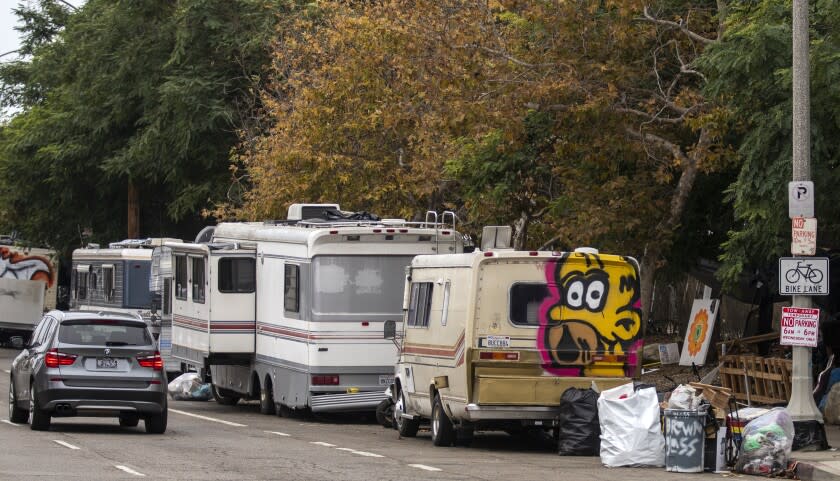Letters to the Editor: Homeless shelters don't work. Use California's $31-billion surplus to build housing

To the editor: What a juxtaposition presented by two of your recent articles — in Los Angeles, people who live in houses hate to see people who don't, and the state is awash in cash.
I've watched the causes of homelessness change over the years. Now, the problem is that rents are too high for people without good-paying jobs. Currently, the answer is more housing, and the state has the money to provide it.
Quick shelters are not the answer. I've heard stories of people who are working on their sobriety in beds in giant rooms with people who are intoxicated. I've heard of people losing the shoes on their feet while they sleep.
Project Roomkey works for some people, but others can't abide the strict curfew. I spoke to one such person who was experiencing homelessness on my street. He values his freedom, as I do.
The state can build more housing, but in the meantime it should repurpose buildings businesses have vacated when they were forced to close because of the pandemic. And people who live in housing can find the humanity to contact their state representatives instead of blaming those less fortunate for the failures of their government.
Marsha Temple, Los Angeles
The writer is executive director of the Integrated Recovery Network.
..
To the editor: How will the $31-billion state government budget surplus be allocated in view of the outdated Gann limit from 1979?
While there exist many needs (homelessness is perhaps the most newsworthy these days), we should allocate much of that $31 billion to higher education in California.
The University of California system has the world's top-ranked public universities and is the engine that has led California to be the world's leading technology center and the fifth-largest economy. Yet state spending on higher education has dropped to just 12% of the general fund. Even more shocking, since 1977, state funding per student at the UCs has fallen from more than $23,000 per student to about $8,000.
There are lots of worthy potential recipients of the $31-billion surplus, none more so than our higher education system, which has proved so beneficial to our state and to the world.
Ken Goldman, Beverly Hills
..
To the editor: Crowing about a "budget surplus" when you chronically underfund pensions is a neat trick.
If any directors of a publicly traded company balanced a budget by simply keeping pension obligations off the books, they would be justifiably prosecuted. Any honest accounting of the state budget should reflect this, and we should see that there is no real surplus at all.
George Yates, Simi Valley
..
To the editor: Californians can thank Gov. Gavin Newsom and former Gov. Jerry Brown for the turning a $13-billion deficit into a $31-billion surplus in 10 years. This is unlike our former Republican president, who increased the national debt by $7.8 trillion during his four years in office.
Ironic, isn't it — when it comes to being fiscally responsible, the conservatives are not.
Martin Mangione, Arroyo Grande
This story originally appeared in Los Angeles Times.

